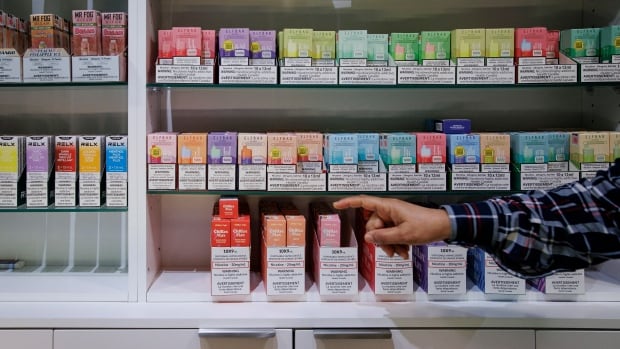
This is an excerpt from Second Opinion, a weekly analysis of health and medical science news emailed to subscribers. If you haven’t subscribed, you can do that by clicking here.
Health Canada is “missing in action” on the regulation of e-cigarette flavours in Canada as youth vaping rates rise, health advocates say, and at a time when the vaping industry is expanding into highly addictive new devices that experts warn appeal directly to kids.
The federal government sounded the alarm in June 2021 over a “rapid increase in youth vaping in Canada” and proposed changes to the Tobacco and Vaping Products Act to regulate the sale of “desirable flavours” helping drive the rising use among teens.
But two years later, Canada still has some of the highest rates of youth vaping in the world and little action has been taken to regulate flavours at a national level.
Vaping has been marketed as an effective way to quit smoking, but e-cigarettes have never been approved as smoking cessation aids in Canada.
The federal government’s proposal to restrict e-cigarettes flavours — such as cereal milk, cotton candy, “unicorn milk” and “dragon’s blood” — was expected to help make vaping products “less appealing to youth” while still giving adults trying to quit smoking some flavour options to choose from.
But experts and health advocates say Health Canada seems to have shelved the proposal, walked away from further regulating flavours that appeal to youth and left it up to the industry and provinces to take action.
“It’s been several years since governments were advised about the need to regulate e-cigarettes and vaping devices thoughtfully and appropriately,” said Dr. Andrew Pipe, a heart specialist and physician in Ottawa dubbed the “Indiana Jones of smoking cessation.”
“The federal government has frankly been missing in action, which is inexplicable to me,” he added. “The silence of Health Canada is deafening.”
David Hammond, a public health professor at the University of Waterloo and a leading Canadian youth vaping researcher, said the federal government implied they were either going to, or were considering, banning flavours, but “they’ve not done anything.”
“They’ve never said publicly that they’re not going forward with further flavour restrictions,” he said. “But I think it’s safe to infer that they’re not, because they just haven’t moved on it.”
Meanwhile, the vaping industry has dramatically expanded its availability of flavours and recently shifted to new discrete, disposable e-cigarettes that hold thousands of pre-loaded puffs, don’t require refilling or cartridges and are linked to a surge in youth vaping.
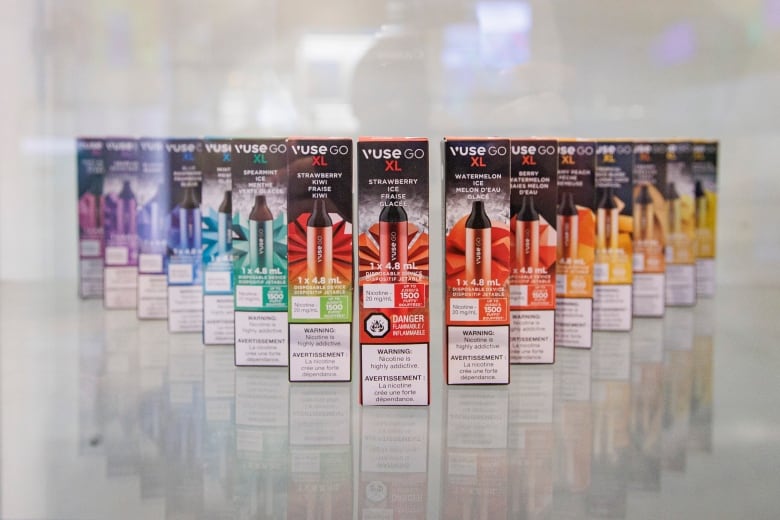
“They’ve been shown in the United States and the United Kingdom to be very popular among youth,” said Rob Cunningham, senior policy analyst at the Canadian Cancer Society.
“A teenager can have it with him or her all the time in their backpack or their pocket and there’s no liquid or pods at home for their parent to find.”
Provinces, feds split over vaping regulations
In the absence of national regulations, multiple territories and provinces have taken action, with Northwest Territories, Nunavut, Nova Scotia, New Brunswick, P.E.I. and Quebec now banning the sale of most e-cigarette flavours, in an effort to curb youth vaping.
The vaping industry and the major Canadian tobacco companies that sell e-cigarettes across Canada say they have no intention of attracting youth to vaping, and that the variety of flavours they offer serves a broader purpose of vaping as a smoking cessation strategy.
“Flavours are a key component of vaping’s efficacy,” said the Canadian Vaping Association in a statement to CBC News, adding that the provinces’ flavour prohibitions violate the “constitutional rights of vulnerable people” to access effective harm reduction products.
“The result will be the elimination of the regulated market and the creation of an uncontrolled black market. Flavour restrictions lead to increased risk to youth, fewer jobs, and more smokers.”
Not only has vaping not been approved as a tool for quitting smoking, but Hammond said the rate of smoking cessation in recent years has been largely unaffected by the rising rate of vaping in Canada, which banned flavoured tobacco products in 2010 and outlawed menthol cigarettes in 2017.
Ontario and B.C. have taken a drastically different approach and allow the sale of colourful vapes in almost every flavour imaginable, as long as they are sold in specialty stores to adults over 19. Alberta has gone a step further and allows them to be sold anywhere tobacco products are available.
Experts say these approaches leave much more room for underage youth to access these products.
“It’s ludicrous,” said Pipe. “It is a complete failure to develop responsible public health legislation to address this current [youth vaping] pandemic.”
Hammond said the relative importance of vaping flavours is much more significant to youth than it is to adults trying to quit smoking, and data shows Canadians aged 15 to 19 used flavoured e-cigarettes at a much higher rate than older age groups.
“The main reason why adult smokers vape is because they don’t want to die from smoking, and because it’s less harmful,” Hammond said.
“You don’t have to be a scientist to determine that a highly addictive drug in lovely pink, modern packaging, in cotton candy flavour, appeals to kids.”
Canada has some of the world’s highest rates of youth vaping
Canada has been slow to collect data on youth vaping rates across the country. But what we do know is that rates of vaping have increased dramatically among Canadian youth in recent years, many of whom never smoked cigarettes.
Youth vaping rates doubled between 2016 and 2019, when 20 per cent of students reported using an e-cigarette in the past 30 days, up from 10 per cent in 2016-17, according to the Canadian Student Tobacco, Alcohol and Drugs Survey.
A survey of more than 12,000 Canadians aged 16 to 19 published in JAMA Pediatrics also found that the number of those who reported vaping in the previous month had more than doubled between 2017 and 2019 (8.4 per cent to 17.8 per cent).
Meanwhile, 13 per cent of teenagers aged 15 to 19 said they vaped at least once in the past month, according to the national 2021 Canadian Tobacco and Nicotine Survey, compared with just four per cent of adults aged 25 or older.
Health Canada did create new regulations on the amount of nicotine allowed in e-cigarettes, setting a maximum nicotine concentration of 20 milligrams per millilitre as of July 2021. But it has not enforced any regulations on flavours.
“Over the last 15 years, there’s been a growing divide [on regulating flavours] and Health Canada is not in the middle and is definitely on the pro-vaping side,” said Cynthia Callard, the executive director of Physicians for a Smoke-Free Canada.
“And the provincial governments, by and large, are on the more cautious side.”
When asked directly, Health Canada told CBC News it wasn’t “providing interviews on this subject.” But it said in an emailed statement it is still reviewing feedback from its public consultations, which “attracted considerable attention” — and ended in September 2021.
“Health Canada is considering measures in response to feedback from the more than 25,000 submissions it received through its consultations on proposed regulations and amendments to limit flavours in vaping products,” a spokesperson said.
A vaping advocate organization called Rights 4 Vapers claims it is responsible for submitting 24,000 of the 25,000 comments Health Canada received during the public consultation process, in the form of a mass postcard writing campaign called #SaveOurFlavours.
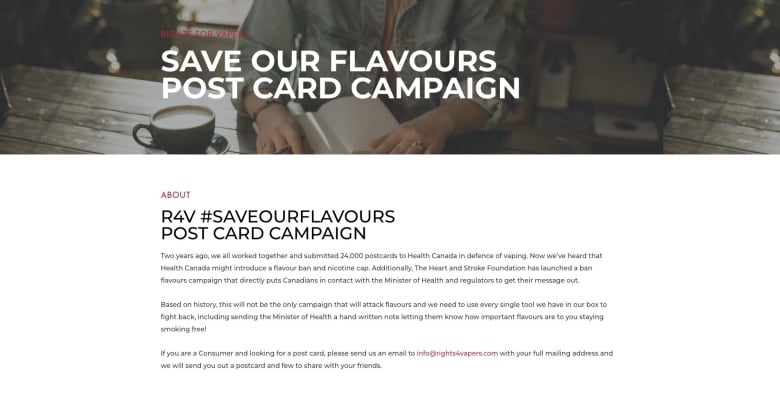
CBC News emailed the organization through its website for comment and did not receive a response. The website’s domain is registered with an online privacy protection company, making it unclear who the site’s owner is.
Christopher LaLonde, a University of Victoria psychology professor listed as the first team member on the website and an “academic advisor” to the group, declined to be interviewed.
“The notion that Health Canada is still processing and working through these submissions does not make sense to me given that they were received 2½ years ago and they have already reported on their consultation feedback in a few different reports,” Hammond said.
“There is a very strong industry lobby group for vaping, which has coalesced into two main groups — large tobacco company-owned brands vs. smaller vape shops — who share common ground on some, but not all issues.”
Rights 4 Vapers has also registered with Elections Canada as a third party, as CBC News previously reported. Its financial agent is listed as Michael Meathrel, president of Dvine Laboratories, which produces flavoured liquid for e-cigarettes that contain nicotine.
Meathrel was also chairman of the Vaping Industry Trade Association in 2021. That association counts Juul Labs Canada, Imperial Tobacco Canada and JTI Canada Tech among its founding members. (Juul Labs Canada left the association in 2021.)
Lobbying records show Health Canada’s Tobacco Control Directorate met with advocates from the tobacco and vaping industry 68 times between 2017 and 2022, while the Canadian Vaping Association has lobbied the federal government more than 500 times in three years.
In one month alone, Darryl Tempest, the CEO of a consulting firm and former executive director of the Canadian Vaping Association who still speaks on its behalf, met with a dozen sitting members of Parliament in January 2022.
Meanwhile, Imperial Tobacco Canada, which makes Vuse GO disposable e-cigarettes, has lobbied the government 120 times since 2009, while Rothmans, Benson & Hedges, makers of the VEEV disposable vapes, lobbied them 90 times in the same time period.
Disposable vapes taking over market
The most popular brand of disposable vapes is Elf Bar, a Chinese device that emerged in 2018 and holds up to 5,000 puffs in a device roughly the size of an AirPods case. It comes with a variety of flavours, like Blue Razz Lemonade and Peach Ice, and is widely available in Canada.
While it allows flavoured e-cigarettes to be exported, China has banned all flavours domestically except for “tobacco.” (Ukraine, Lithuania, Finland, Estonia, Hungary and The Netherlands have done the same.)
The Elf Bar is behind a major spike in youth vaping in the U.K., where 2021 National Health Service figures show nine per cent of 11- to 15-year-olds vaped, up from six per cent in 2018. (The 2021 rate among 15-year-olds alone is 18 per cent.)
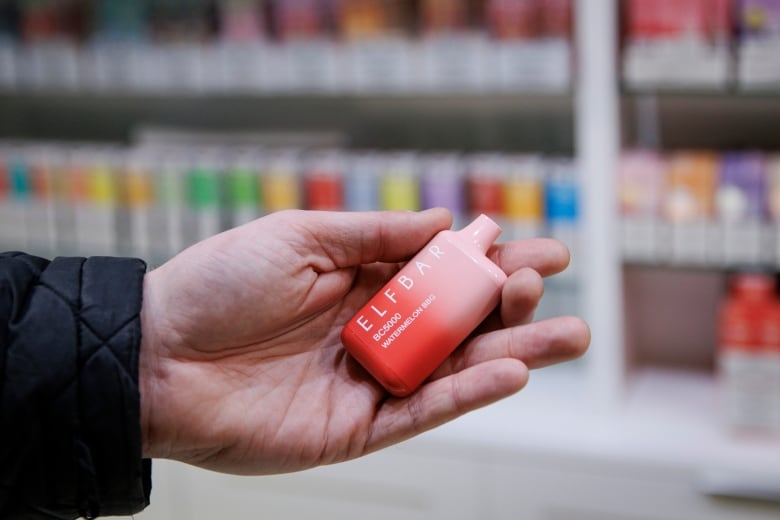
NHS data shows the use of disposable vapes among 11- to 18-year-olds has also grown dramatically recently in the U.K., with 52.8 per cent of youth vapers using them in 2022, compared with just 7.8 per cent in 2021 and 5.3 per cent in 2020.
Hammond said Elf Bar is almost exclusively behind the surge in popularity with disposable vapes in the U.K., adding that the device uses the same nicotine salt liquid that was developed by e-cigarette maker Juul.
“What that means is it makes it even easier to inhale more nicotine,” he said. “It’s certainly responsible for what we’ve seen in terms of greater levels of dependence and more frequency of use among kids,” he added, with some disposable vapes on the market holding up to 10,000 pre-loaded puffs in a single e-cigarette.
“Many of [Elf Bar’s] varieties have a high-capacity tank. Why does that matter? Because it’s great for kids that don’t want to have to go to a store and try and buy products all the time,” said Hammond.
And in the absence of federal legislation, major Canadian tobacco companies like Imperial Tobacco Canada and Rothmans, Benson & Hedges have recently developed their own disposable vapes, which closely mimic the highly addictive model.
“They chose to promote one type of product in the last six months in Canada,” said Hammond. “And what is it? It’s basically the same product that took off among kids in the U.K.”
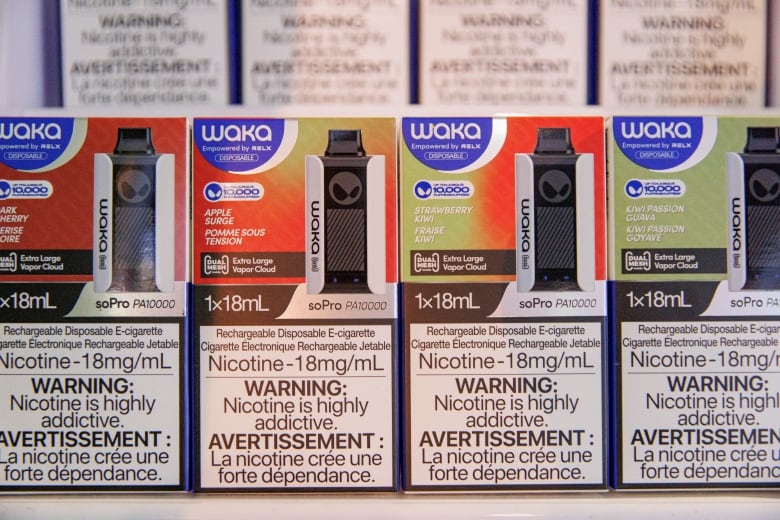
Longer feds wait, ‘more youth become addicted’
In a statement to CBC News, Elf Bar said it strictly adheres to domestic and international laws and regulations that prohibit minors from buying and using their products.
“We are aware of the actions taken by Canadian provinces. As such, we are closely monitoring the development of any new regulations and will follow them accordingly,” Elf Bar spokesperson Tom Li said in an email.
“Regarding our products, they are all designed for adults who are over the legal age of vaping. Elf Bar is committed to applying every effort to limiting minors’ access to any vaping products, from product development and marketing to sales.”
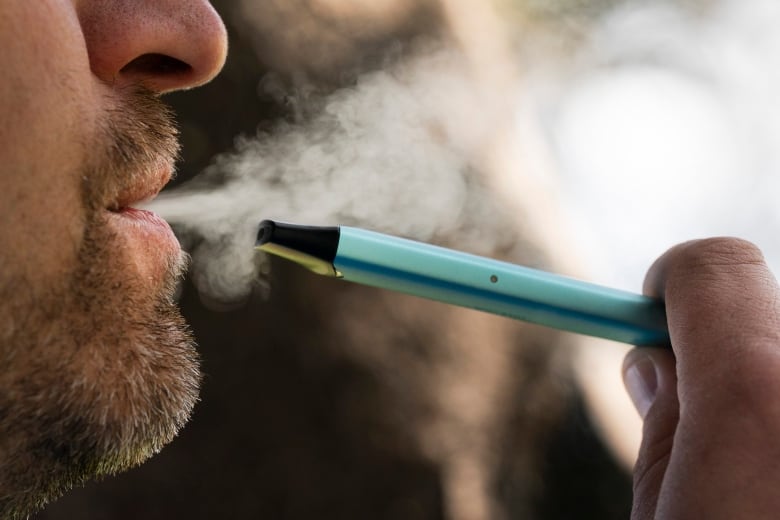
Imperial Tobacco Canada is “committed to offering adult smokers a range of less harmful products, including Vuse GO,” said Eric Gagnon, vice-president of legal and external affairs, in a statement.
“Imperial Tobacco Canada’s position is clear and has been consistent since day one: Minors should neither smoke nor vape, and tougher fines and penalties must be imposed on those caught selling to youth.”
Rothmans, Benson & Hedges believes “that no tobacco or nicotine-containing product should ever be in the hands of a non-legal age Canadian or an adult that isn’t currently smoking,” according to a statement from a company spokesperson.
“We all have a responsibility to ensure that the right products get to the right people in the right way. As smoke-free products are introduced — like RBH’s disposable vaping product — we ensure that they comply with all Health Canada’s standards.”
Vaping giant Juul reached a $462 million US settlement with New York, California and several other U.S. states earlier this month, ending a series of lawsuits over claims that the company had aggressively marketed its e-cigarettes to youth and fuelled a vaping crisis.
The vaping industry has come a long way since Juul decided to pull most of its flavoured vapes out of Canada in 2020, after Health Canada signalled it would take stricter action on flavours. The industry shows no signs of slowing down in the absence of further regulations.
Cunningham said the proliferation of thousands of e-cigarette flavours on the Canadian market is a “major reason” why so many youth in Canada vape. He’d like to see significant action to respond to that.
“We now have six provinces and territories in Canada that have moved forward with this measure to ban flavours in e-cigarettes … If six provinces and territories can do it, so can the federal government,” he said.
“It has been almost two years since they published the draft regulation, and the longer the federal government waits, the more youth who become addicted.”